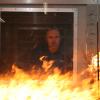Research leader
Research team
End User representatives
This project was commissioned and funded entirely by the Department of Environment, Land, Water and Planning, Victoria.
Determining the mechanisms by which fires transition from bushfire and subsequently spread as urban fires is essential in describing hazard and risk and determining the potential impact on houses, structures and people at a particular given bush/urban interface. Possible fire transition mechanisms may include: direct flame contact, radiant and convective heat, firebrands or various combinations.
The events which result in significant loss and damage are usually large, rapidly spreading and propagating fires, usually occurring during conditions of Very High to Catastrophic Fire Danger, and are uncontrollable until weather conditions abate. Significant fires occur somewhere in Victoria at an average interval of about three years, and climate change predictions imply that their frequency will increase. In addition, demographic factors indicate that more people and infrastructure will be vulnerable in the coming decades. It is arguable, based on historical fires, that in some regions of Victoria the average return interval is about 50 years, and this implies that the likelihood of recurrence at a particular location during a 25 year period is almost 40%. This statistic, and the fact that in spite of vastly improved communication, access, travel and transport speed and vastly increased resourcing, the pattern of losses and damage is apparently unchanged, underlined the importance of this study.
This project determined the fire behaviour characteristics and mechanisms that enable fires in landscape vegetation to transition into non continuous fuels where urban assets reside. This transition behaviour information is a vital link in the proposed revisions to the National Fire Danger Rating System between the Fire Behaviour Index (a measure of the potential behaviour of a particular fire) and the Fire Damage Index (a measure of the potential for that fire to adversely impact infrastructure and societal values and thus is crucial in defining the level of exposure in an urban scene. This was achieved through a combination of case study analysis of major fire events where sufficient reliable information exists, experimental datasets and findings, documented observations gathered for inquiries, commissions and litigation, and modelling of fire propagation processes in urban settings.
The first step involved identification, selection, acquisition and collation of suitable case study datasets. Selection criteria was determined based on reliability and applicability, to ensure a comprehensive range of case study examples that covers the full breadth of possible fire transitions behaviours under conditions and situations applicable to Victoria. This included analysis of fire behaviour observed outside Victoria (e.g. interstate and overseas fire events). Specific historical fire events included Beaumaris 1944, Hobart 1967, Western District 1977, Ash Wednesday 1983 (Macedon, Lorne), Canberra 2003, Wangary 2005, Black Saturday 2009 (Kilmore East, Bendigo).
Analysis involved construction of a summarisation framework that captures critical variables for each fire impact event. These included: fire behaviour characteristics for the full gamut of propagation mechanisms; weather, topography and landscape fuel conditions; and evidence of exposure in the urban scene. The summarisation framework employed the matrix method to organise the resulting set of observations. This approach enabled several aspects of the observations to be monitored, such as longitudinal aspects, conceptual clusters, and the inter-relationships between measured quantities.
Probability and likelihood analysis (perhaps featuring Chi-squared or logistical modelling) was employed to quantify propagation transition mechanisms and resulting exposure evidence as well as the determination of reasonable worst case scenarios for given configurations. In parallel with this approach, relevant models of flame propagation were employed to complement the results obtained through the statistical analysis. In addition, physical models of fire propagation in urban fuel settings (e.g. US Forest Service Wildland Fire Simulator, WFDS) and methodologies arising from the Bushfire Risk Toolbox project were considered.
Thorough understanding of the mechanisms and processes by which bushfires transition into urban scenes is essential to underpin management decisions concerning areas within and outside communities. A key output from this project is the relation of the findings to potential fuel management methodologies (DELWP Code of Practice), policies and objectives.











